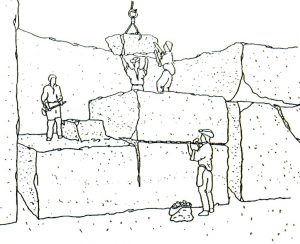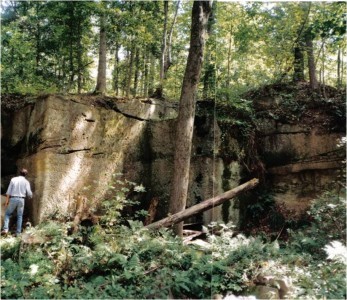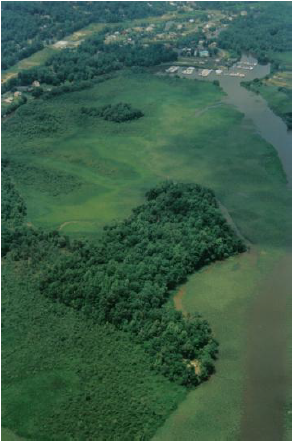Government Island – Freestone Industry
Nestled close to the shore of Aquia Creek, near the Aquia Harbour Yacht basin, is a small island. It appears to be an extension of land as its western shore is actually joined to the mainland by a marshy bog. For years leaving Aquia Harbour Marina pass by the inconspicuous island.
This unpretentious piece of land, currently known as Government Island, was previously called Brent’s Island. Here stone was quarried to build the White House and U.S. Capitol.
The stone that comprises much of the island is an arkose sandstone. Although tough, this rock could be carved freely without breaking. Virginia’s early settlers referred to it as “freestone” or Aquia stone. Freestone was not limited to the island but also was found along Aquia Creek and the Rappahannock River. However, the stone upon the island was very finely grained and was very white in color.
On various sites on the island, Indian artifacts dating from 500 to 1600 A.D. have been discovered. These disclose its prerecorded history. The first-time history recorded the island was in a November 28, 1678 land patent. It mentions that King Charles II of England bestowed 12 acres (today the island measures 17 acres) of land to two gentlemen. This transaction did not take place. However, in 1694, a George Brent, nephew of Stafford’s first English settler, Col. Giles Brent, acquired the land. Brent operated a quarry there because freestone was so plentiful, with cliffs rising 20 to 50 feet tall.
One can assume the stone was first quarried as a building material, for evidence of basements and foundations can be found around Virginia. Tombstones also were made from this soft sandstone. In the early and middle 1700s, most Virginia houses were made of brick and wood. Plantation owners would use brick too, but they would accent with Aquia stone. Aquia Church, built near the island, is an excellent example of how the two materials were combined, for all eight corners are trimmed in stone quoins, and the keystones above windows and door surrounds are of stone. Christ Church in Alexandria and George Mason’s Gunston Hall also combine brick and Aquia stone.
George Washington was familiar with the Brent quarry: entries in his diary from 1774 and 1786 mention his sending men to the quarry to obtain stone for steps.
In June of 1791, President Washington and three commissioners began planning a new capital city which would be built on ten square miles comprised of land in Virginia and some in Maryland. The commissioners asked Pierre L’Enfant to search along the lands of the Potomac River for stone to be used to construct a President’s House and U.S. Capitol. He selected the quarry on Brent’s Island. Ironically, after nearly a century, the quarry was still owned by a Brent, George Brent. In December, the United States Government took title of the island for $6,000.00 or 1,800 pounds Virginia currency.
Common labor was not hard to obtain, for residents were eager to have their enslaved people be hired since their wages were paid to the enslavers. However, skilled workers and stone cutters were difficult to find, so they were enticed with offers of free travel abroad, including passage for their wives. Most came from Scotland, Holland, Germany, and France.
Laborers worked from sunrise to sunset and received 75 cents per day. The skilled mechanics initially worked from 6 AM to 6 PM with their hours later reduced to 10 per day; their daily pay ranged between $1.25 and $1.75, with the exception of the overseer of the stonecutter, who received the highest daily wage of $3.75. Besides money, each man was paid one pound of pork or a pound-and-a-half of beef along with one pound of flour (bread) per day. Quarters were set up on the island.

The tools used to quarry the stone were pick axes, mauls, and wedges. (Pick marks are still evident today on the island cliffs after 200 years.) Once the stone was cut, it was moved by pulleys and placed on skids. The skids would be pulled to the water’s edge by oxen. The heavy stone (one cubic foot weighs 120 pounds) would be placed on a masted boat. This boat would travel down Aquia Creek and then travel north for 40 miles on the Potomac. Once it reached the district, some of the stone would travel to the site of the presidential mansion, while the rest of it would be unloaded near the site of the present-day Botanical Gardens for use in the construction of the Capitol.
The President’s House was to be made entirely of stone, but it was difficult to get the entire amount needed. Therefore, the commissioners passed an order than a half-pint of whiskey would be provided to each man at the quarries, hoping that this would increase production. They also requested 25 more “able-bodied male negro slaves.” Both these measures failed to bring about the desired increase in production, so the commissioners decided that instead of being all Aquia stone, the walls would be reinforced with brick.
After the Civil War, the state of Virginia took possession of lands that were abandoned. They considered the island to be such a land as all records of government ownership were destroyed by the Union soldiers at the Stafford Courthouse in 1862. It was only in the 1960s that the true ownership of the island was unearthed.
In 1998, the Stafford Board of Supervisors, purchased the island to save it from development. On November 6, 2010, the island was opened up as a Stafford County Park enabling people from all around the world to walk to the island on a boardwalk and to view the remains of a quarry which at one time was the most famous quarry in America.

Bibliography:
Conner, Jane. Birthstone of the White House and Capitol. Virginia Beach: Donning Company, 2005 (reprint 2010).

